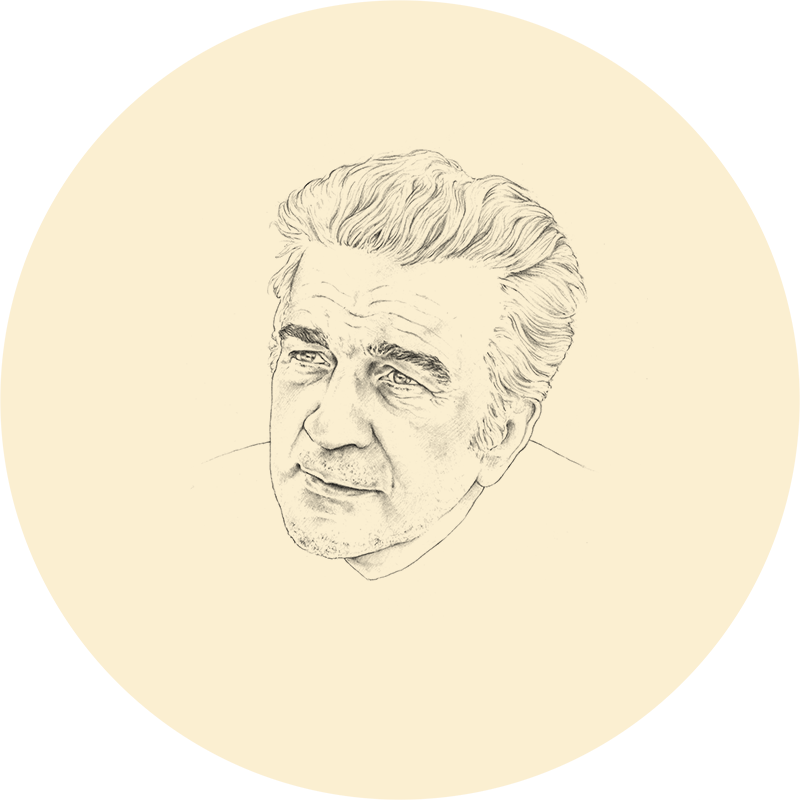Prior, post. In 1957 you had a debut, a solo show, at Galleria del Milione. No longer an artisan, a scholar, a critic. You were an artist. Your sculptures were your voice, they spoke for you. The experience of your labor, the ethic of your vision, the rectitude of your life. Not words, works. The social whirl wasn’t for you. You were not a party animal, not the kind of artist who hung around at Bar Giamaica. Perhaps this too is why they appreciated you more in other countries – after the surprising exhibition at Milione, where it seemed like an artist had appeared out of nowhere, your works found their way into galleries, museums and private collections in Canada, Israel, Australia, Switzerland, Japan, Germany. You had solo shows in New York, you worked on a monument for a square in Eindhoven. And in Milan you stayed closed up in your studio.
Before, once the war was over, on Via Pellegrino Rossi, after on Via San Calocero and Via Pisacane. Until you finally reached Via Stoppani 7. Your house was right across the street. Gillo Dorfles lived close by, at Piazza Lavater, but you never went to see him. You preferred walking by the antique stores, talking with Giovanni Mazzaglia who had a shop on Via Stoppani, with Cesati, a dealer in antique ironwork, on Via Baldissera, Carlo Ferrero on Viale Regina Giovanna, or Gustavo Mazzola, an art dealer, on Via Nino Bixio. To relax, you went to Cinema “Delle Stelle” on Via Frisi, alone of course. You loved Bresson and Dreyer. Your neighborhood was your world, it was enough for you.
You were not being haughty or conceited. You were a loving husband, a tender father, your friendships were intense, deep, joyful. The creator of jewelry Karl-Heinz Reister came to visit you at the studio, or the photographers Paolo Monti and Arno Hammacher. With Enrico Della Torre you spent long summers at Teglio or Aprica. At dinnertime you had long phone calls with Giovanni Testori. But you knew that an artist can express himself only in solitude. Avoiding tricks, theories and shortcuts. The artist had to become anonymous, only his art had to express itself. You remained in your studio on Via Stoppani – the outer, physical manifestation of your inner world, its concrete outcome – ascetic, not unlike some of your bronze columns. You were like the figurine perched on top, an anchorite of art, a stylite monk. From the heights of your spiritual perch you viewed the world with humility and dedication. You weren’t looking for approval, you didn’t want praise. You refused to make a memorial to the victims of Aprica because you did not agree with the client about the concept of the “monument.” Your sculptures were humble, like little country churches, yet they were monumental, not through size, but through scale, impetus. You refused to work for the 11th National Quadriennial in Rome, because you were busy writing about the sculpture of Modigliani. You remembered what Anna Achmatova said about him. “He was surrounded by a compact ring of solitude.” That of the true artist. Your solitude, Mario.
They invited you to compete in Germany. In Belgium they appointed you to the academy, in Austria they held traveling exhibitions of your work, precisely during the years of the so-called “Milano da bere,” of the widespread corruption of the followers of Craxi, so distant from your ideas of socialism based on solidarity, a sense of measure and reserve. You advised young sculptors to strive for the absolute, the essential, the “True.” “Every sculptor, if he is a sculptor, is a primitive,” you told Franco Russoli, Vittorio Sereni, Vanni Sheiwiller.
There were always a before and an after for you, Mario. Except for the last time, when the owner of your rented studio urged you to buy it: “either you buy, or you leave.” You owned nothing, you didn’t even have a driver’s license. But how could you dismantle your whole world, your monastic retreat, constructed year after year, stone after stone, precisely when you were preparing a retrospective for Palazzo Te, in Mantua? It was too much for your sensitive soul. A stabbing pain in your heart, rushed to the Centro Cardiologico Monzino, hours of waiting on the stretcher. Then, when it seemed to have subsided, as you were lacing up your shoes for the trip home, came the heart attack. Just a few weeks before the retrospective was slated to open. An honor you had never sought, but one that came culpably too late in such an ungrateful country. You were not there. Cruel and coherent, the artist was not present. His works spoke for him. With your voice.
